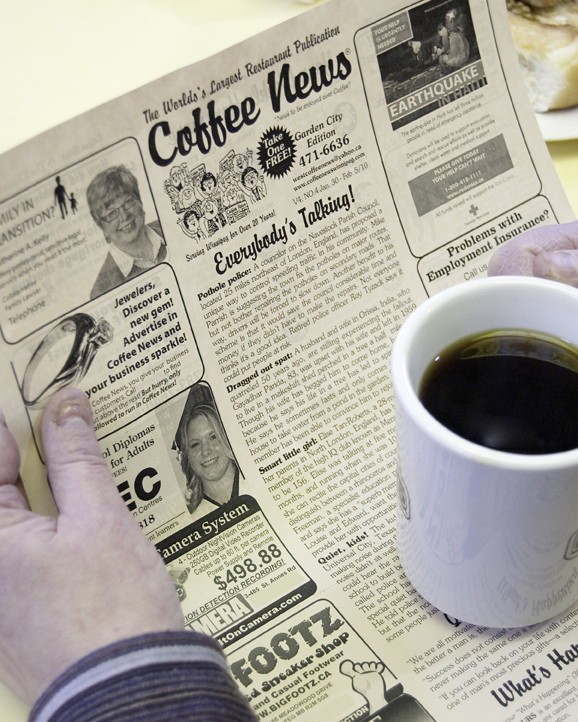Coffee News avoids the print media grind
Restaurant reader able to grow business with ad space and low printing cost
While major daily newspapers are closing or moving entirely online, the one-page Coffee News is expanding its turf and distribution.
The Coffee News, which started in Winnipeg, is a one-page, double-sided weekly publication dropped off at restaurants and waiting rooms across North America. The content of the paper typically includes a couple of 100-word articles (roughly the size of a CD review in The Uniter), a trivia section, horoscope, crossword puzzle and the like.
Content accounts for about one third of the paper. The other two thirds is advertising.
“[People] get bored reading the material and begin reading the ads. That’s by design,” said Bill Buckley, president of Coffee News.
Coffee News targets small businesses like local hairdressers and mom-and-pop shops as potential advertisers because each edition is hyper-localized to specific areas of the city, as opposed to local papers with higher distributions.
“If you buy an ad, you have to pay for all that circulation, whether you can use it or not,” Buckley said.
Alastair Gillespie, a partner in Coffee News Winnipeg, would not comment on the citywide distribution of the paper, but estimates it has 90,000 readers per week.
Local community papers such as The Herald, The Lance and The Metro don’t consider Coffee News as competition for ad space.
“They found a niche market,” said John Kendle, editor-in-chief of Canstar, which publishes those community weeklies, as well as Uptown magazine. “[Those advertisers] probably couldn’t afford to take ads with us. This might be a good outlet for them.”
Gillespie agrees.
“I don’t like to think of it as competition. We’re doing a different thing.”
Racks of the paper are usually placed in restaurants where there are lineups to keep customers busy.
“You can get fidgety and you can get annoyed [in line]. It’s good for the restaurant because it gives [customers] something to do,” said Gillespie.
“People are less likely to bolt and run if they have something to read,” said Buckley.
Buckley estimates Coffee News takes about 10 minutes to read. Along with the short word count and distribution in 21 countries, including 161 franchises in Canada, Coffee News doesn’t print what many would call “real news.”
Another difference with other venues of print media is that rather than struggling, Coffee News is thriving and expanding. Because the business model requires such small printing costs, the Coffee News franchises are able to largely avoid what is usually the largest overhead cost for publishers: printing.
“The largest overhead cost [for Canstar] is our printing,” said Kendle. “We have 180,000 copies of the community papers throughout the city and 17,000 with Uptown, so that makes 197,000.”







